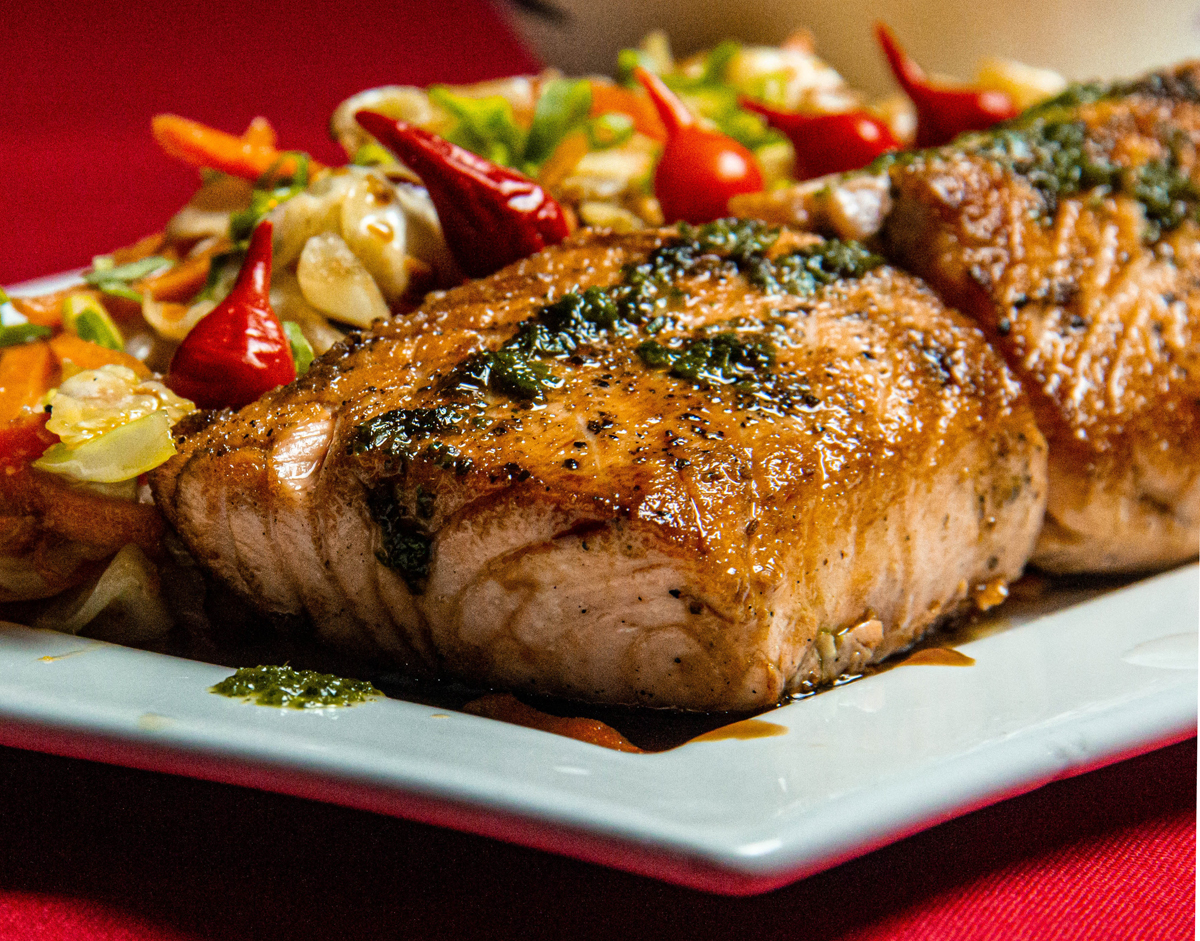Contact Me: howtopbestinfo@gmail.com
Contact Me: howtopbestinfo@gmail.com
To make the most of your freshly cooked salmon or if you've prepared a substantial batch for enjoyment over the next few days, it's crucial to store it correctly for both taste and health. Additionally, learn how to tell if salmon is bad by considering its smell, appearance, and texture. In the following discussion, we'll cover the shelf life of cooked salmon in the fridge and provide best practices for ensuring the safety of your fish. Laden with omega-3 fatty acids, protein, and vitamins, cooked salmon serves as an excellent choice whether you're seeking a quick, effortless dinner or a more substantial meal. Whether you're new to cooking salmon or seeking fresh recipe ideas, understanding how long is cooked salmon good for, is essential.

Initially, salmon stands out as a high-protein food, and foods abundant in protein are susceptible to spoilage more than other types of food. Furthermore, due to its significant moisture content, salmon becomes even more susceptible to spoilage, the tendency to cook salmon at lower temperatures can result in the survival of harmful bacteria. Moreover, refrigeration plays a vital role in upholding the cooked salmon's freshness and overall quality. The cold environment within the refrigerator effectively retards the pace of spoilage, thereby maintaining the fish's texture and flavor. But how long can salmon sit out depends on your way of presevation, when refrigerated, unopened smoked salmon can remain safe for consumption beyond its indicated shelf life by adding an additional 2-3 days to the package's expiration date. After being opened, smoked salmon can be stored in the fridge for 5-7 days.
Raw Salmon: Frozen raw salmon retains its peak quality for roughly 2-3 months. While it can be frozen for up to six months, its quality gradually diminishes after the initial three months. To freeze raw salmon effectively, begin by rinsing it, patting it dry, and then enclosing it within an airtight container. Remember to label it with the freezing date and utilize it within six months.
For extended storage of opened smoked salmon, securely encase it using heavy-duty aluminum or plastic wrap. When stored correctly, an opened package of smoked salmon can be preserved in the freezer for approximately one month, and it remains safe for consumption beyond that period. When consistently refrigerated, canned salmon maintains its safety for 3-4 days. You can elongate its shelf life by freezing it. If constantly frozen at a temperature of 0°F (-18°C), canned salmon stays safe for consumption for up to 3 months.
Evaluating the freshness of salmon involves several key aspects, starting with its color. A pristine salmon fillet boasts vibrant shades of pink, orange, or even red, adorned with white marbling and glossy skin. Worth noting is the color's reliance on the salmon's type and origin. Remarkably, wild salmon derive their hues from their diet of creatures like shrimp and krill. These tiny organisms harbor carotenoids that confer the distinct color to salmon. Consequently, variations in diet yield divergent hues; sockeye salmon exhibit deeper orange/red tones, while coho salmon feature a lighter pink.
Conversely, deteriorating salmon appears lackluster, assuming a dull or grayish hue, possibly accompanied by dark spots, discoloration, or mold—obvious signs of spoilage. A milky, slimy residue signifies unequivocal spoilage, warranting disposal. For whole salmon, ocular inspection matters; vibrant, prominent eyes indicate freshness, while filmy or sunken eyes suggest otherwise.
Employing the sense of smell emerges as a valuable tool; fresh salmon, including raw varieties, emits a mild scent reminiscent of the ocean. Any overpowering fishy or sour aroma signals a lack of freshness, while an ammonia-like odor spells trouble.
Physical assessment plays a role too: Firmness is a hallmark of fresh salmon, as it should rebound under gentle pressure. Conversely, a mushy or fragile texture signifies deterioration. When touching the salmon, smoothness is expected; sliminess or stickiness serves as a red flag.
In conclusion, the color, scent, and texture of salmon offer crucial insights into its condition. A blend of visual, olfactory, and tactile cues empowers consumers to distinguish between fresh and spoiled salmon effectively.
Delayed Refrigeration or Freezing: Failing to promptly refrigerate or freeze cooked salmon after cooking enhances the likelihood of bacterial proliferation and food spoilage.
Unprotected Exposure: Leaving cooked salmon uncovered and exposed to air accelerates the growth of detrimental bacteria and moisture, hastening its deterioration.
Inadequate Temperature Control: Storing cooked salmon at incorrect temperatures, whether excessively hot or cold, can impact its longevity, freshness, and nutritional integrity.
Neglecting Container Hygiene: Overlooking proper cleaning of cooking and storage containers introduces harmful bacteria, which might result in foodborne illnesses.
Cooked salmon encompasses salmon that has undergone various cooking techniques such as baking, grilling, frying, or pan-frying, and it can also be prepared through canning or smoking methods. This distinct pinkish-orange fish inhabits both the Pacific and Atlantic oceans.
Renowned for its health benefits, salmon stands as a nutritional powerhouse due to its rich content of omega-3 fatty acids, protein, and vitamins. Its nutrient density and relatively low caloric profile render it a favored dietary option.
Omega-3 fatty acids play a pivotal role in bolstering heart health by mitigating blood pressure and diminishing the risk of cardiovascular ailments. Additionally, they exhibit potential in enhancing cognitive function and curbing inflammation.
The inclusion of protein in salmon is indispensable for muscle development and inducing post-meal satiety. Concurrently, the presence of Vitamins A and D contributes to upholding robust skin and bone health.
Room temperature storage for cooked salmon is safe for a maximum of 2 hours. Beyond this period, refrigeration or disposal is necessary. In hotter environments, consumption within an hour is advised to evade the danger zone.
The danger zone denotes the temperature range conducive to bacterial growth. Falling between 40°F and 140°F (4.4°C to 60°C), as defined by the USDA, this range fosters rapid bacteria multiplication and the risk of food poisoning. Keeping cooked salmon clear of the danger zone is vital to prevent foodborne diseases.
Conversely, it's essential to prevent contact between cooked salmon and raw meat or poultry. Maintaining this separation thwarts cross-contamination and upholds food safety standards.
Is raw salmon still safe for consumption after spending 3 days in the fridge? Yes, provided it has not entered the "danger zone" where bacterial growth becomes a concern.Oxygen exposure accelerates bacterial multiplication, necessitating the use of airtight containers for refrigerated food storage to prevent spoilage.
The danger zone commences at 35 degrees Fahrenheit (1.7 Celsius) and persists for 24 hours.Consequently, if your salmon has been refrigerated for over 24 hours, it's advisable to discard it.Yet, if the refrigeration duration is below 24 hours and the salmon remains suitably cold, it's considered safe for consumption. The temperature should range between 40-45 degrees Fahrenheit (4-7 Celsius).After 48 hours in the fridge, it's prudent to consider discarding the salmon. Nonetheless, it's important to note that even if refrigerated for 72 hours or more, the salmon remains safe to eat as long as it maintains the appropriate cold temperature.
Efficient post-cooking storage is pivotal to maintain the quality of prepared salmon and prevent spoilage. Here are essential recommendations for storing cooked salmon:
Segregate from Raw Items: Prudently avoid co-mingling cooked salmon with raw meat, poultry, or seafood. Dedicate a distinct section within your refrigerator or freezer for its storage.
Swift Refrigeration: Upon cooking, promptly encase the cooked salmon in an airtight manner and place it in the refrigerator within a two-hour window.
Air-Tight Freezing: To avert freezer burn, ensure the freezer bag is void of any residual air before sealing.
Methodical Thawing: Safeguard the salmon's integrity by thawing it in the refrigerator overnight before proceeding with cooking.
One-time Thaw: Once thawed, refrain from refreezing the salmon to maintain its texture and quality.
By adhering to these storage practices, you ensure the enjoyment of delectable and healthful cooked salmon over an extended period.
The storage duration of cooked salmon in the fridge typically spans 3-4 days, though this is a general guideline influenced by cooking and storage methods. It's essential to trust your senses; discard any salmon that appears or smells off. When uncertain, it's prudent to exercise caution.
Having grasped the fridge shelf life of cooked salmon, capitalize on this knowledge by experimenting with our highlighted recipes. Salmon's adaptability lends itself to diverse culinary creations, suitable for both quick weeknight meals and upscale dinner gatherings.
Maximize longevity by employing an airtight container for fridge storage, considering salmon's delicate nature. Enjoy your freshly cooked salmon within a short timeframe to savor its optimal taste. Thank you for reading, and relish your delectable salmon experience!


Hello! Glad you are here.We share knowledge, let's learn sth together to make our life better!